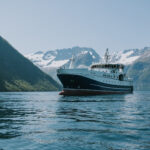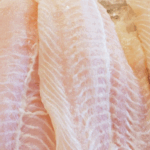With the price of cod and haddock still high and availability patchy, we have worked with the Marine Conservation Society to put together five tasty, sustainable and green-rated additions that are just angling for a spot on your menu
Hake
Hake is a great substitute for cod and haddock. Its firm, white flesh and mild flavour make it a favourite in Spanish cuisine. In fact, it’s so popular in Spain that almost all the hake we catch gets exported there.
Hake can be treated in exactly the same way as your fillets of cod or haddock, so you don’t need to change any processes or train staff. Help celebrate a great British product and put hake on the menu.
The Cornish hake fishery is a sustainability success story. It was in the doldrums in the ‘90s, overfished and under-valued, but good management of the stock has seen it bounce back. It’s now MSC certified and prices have improved for fishers. However, it is still competitively priced compared to cod and the money goes into the pockets of British fishers.
We would suggest sourcing from the Cornish static net fishery, which is green-rated on the Good Fish Guide.
Mussels
Farmed shellfish are probably the most sustainable form of animal protein available. They don’t need any feeding, they filter out all the food they need from the sea, cleaning it as they go. They’re a real superfood and a great climate-friendly option.
We know, they might not be something anyone would associate with a British chippy, but moules-frites are the fish and chips of Belgium! Mussels steam in minutes and would work beautifully with chip shop chips. Alternatively, deep-fry them for a super sustainable scampi.
All farmed mussels are rated 1 on the Good Fish Guide. Whether they’re grown in bags, on ropes or on the seafloor, they’re a great, ocean-friendly choice.
Sprats
Whitebait are hugely popular on pub menus, but for some reason, are less widespread in fish and chip shops. Whitebait is a catch all term for fried baby fish. Worryingly it also encouraged fishers to catch all the baby fish. Eating baby fish is normally a bad idea, so we’d suggest serving sprats.
Sprats have really bounced back in the English Channel and are a really sustainable choice. They’re small fish, growing to a maximum size of a few inches long and are packed full of Omega-3.
Deep-fried sprats should slot into menus easily. Cooked whole – heads, guts and all, there’s very little prep involved. Dredged in flour rather than batter, they cook much quicker than larger fillets and should be a simple addition to your sustainable seafood offering. They come in much cheaper than larger fish fillets too.
Sprats from the English Channel are green rated, however, fish marketed as whitebait should be avoided as it’s hard to know what they are and whether stocks are healthy. Baltic Sea sprats are amber-rated on the Good Fish Guide are an OK choice, but look out for those caught with nets in the English Channel.
Plaice
Back in Victorian times, plaice would be on fish and chip shops menus up and down the land, with tens of millions of them passing through Billingsgate each year. They’re less common and less popular these days, which is a shame.
Fillets of plaice are much more delicate than the meatier (and chunkier) cod and haddock, but perhaps by reframing the offering into a lighter option we could bring plaice back in popularity. Grilled or deep-fried in flour or breadcrumbs, plaice is top notch and much lighter than your standard fish supper. They also come in significantly cheaper than cod and haddock, although the yield is more variable throughout the year.
Stocks of plaice are faring very differently around the UK, so it’s important to know exactly where your plaice is caught. The North Sea and Bristol Channel are the best places to source your plaices. It can get complicated though. If you’d like to simplify sustainable seafood sourcing, sign up to the Good Fish Guide for Business.
Mackerel
Plentiful, flavourful and chock full of Omega-3, mackerel is a great option for our seas and our health.
Mackerel are oily, firm fleshed fish. They stand up well to big flavours – spiced rubs, Asian dressings and punchy pickles all work well. They need fast cooking – frying or grilling work best, but interesting flavour combinations open up space for creativity.
They’re big on flavour, but offer a lighter alternative to your traditional fish supper. They’ll also be lighter on your pocket than cod and haddock.
Best choice mackerel are caught with handlines in Cornwall, but the large fishery in the frozen North is also a great, sustainable choice- both are green-rated on the Good Fish Guide.







